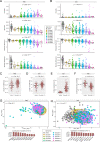T cell repertoire breadth is associated with the number of acute respiratory infections in the LoewenKIDS birth cohort
- PMID: 37308563
- PMCID: PMC10258752
- DOI: 10.1038/s41598-023-36144-x
T cell repertoire breadth is associated with the number of acute respiratory infections in the LoewenKIDS birth cohort
Abstract
We set out to gain insight into peripheral blood B and T cell repertoires from 120 infants of the LoewenKIDS birth cohort to investigate potential determinants of early life respiratory infections. Low antigen-dependent somatic hypermutation of B cell repertoires, as well as low T and B cell repertoire clonality, high diversity, and high richness especially in public T cell clonotypes reflected the immunological naivety at 12 months of age when high thymic and bone marrow output are associated with relatively few prior antigen encounters. Infants with inadequately low T cell repertoire diversity or high clonality showed higher numbers of acute respiratory infections over the first 4 years of life. No correlation of T or B cell repertoire metrics with other parameters such as sex, birth mode, older siblings, pets, the onset of daycare, or duration of breast feeding was noted. Together, this study supports that-regardless of T cell functionality-the breadth of the T cell repertoire is associated with the number of acute respiratory infections in the first 4 years of life. Moreover, this study provides a valuable resource of millions of T and B cell receptor sequences from infants with available metadata for researchers in the field.
© 2023. The Author(s).
Conflict of interest statement
The authors declare no competing interests.
Figures





Similar articles
-
T Cell Receptor Diversity and Lineage Relationship between Virus-Specific CD8 T Cell Subsets during Chronic Lymphocytic Choriomeningitis Virus Infection.J Virol. 2020 Sep 29;94(20):e00935-20. doi: 10.1128/JVI.00935-20. Print 2020 Sep 29. J Virol. 2020. PMID: 32759317 Free PMC article.
-
Evidence for extrathymic changes in the T cell receptor gamma/delta repertoire.J Exp Med. 1990 May 1;171(5):1597-612. doi: 10.1084/jem.171.5.1597. J Exp Med. 1990. PMID: 2185330 Free PMC article.
-
Next-Generation Sequencing Analysis of the Human TCRγδ+ T-Cell Repertoire Reveals Shifts in Vγ- and Vδ-Usage in Memory Populations upon Aging.Front Immunol. 2018 Mar 6;9:448. doi: 10.3389/fimmu.2018.00448. eCollection 2018. Front Immunol. 2018. PMID: 29559980 Free PMC article.
-
Dynamics of thymus function and T cell receptor repertoire breadth in health and disease.Semin Immunopathol. 2021 Feb;43(1):119-134. doi: 10.1007/s00281-021-00840-5. Epub 2021 Feb 19. Semin Immunopathol. 2021. PMID: 33608819 Free PMC article. Review.
-
Thymic function in HIV-infection.Dan Med J. 2013 Apr;60(4):B4622. Dan Med J. 2013. PMID: 23651726 Review.
Cited by
-
Detection of disease-specific signatures in B cell repertoires of lymphomas using machine learning.PLoS Comput Biol. 2024 Jul 2;20(7):e1011570. doi: 10.1371/journal.pcbi.1011570. eCollection 2024 Jul. PLoS Comput Biol. 2024. PMID: 38954728 Free PMC article.
References
Publication types
MeSH terms
LinkOut - more resources
Full Text Sources

